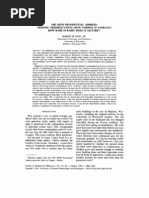0 ratings0% found this document useful (0 votes)
129 viewsMiall 1980
Miall 1980
Uploaded by
SedPaleocyclicity and fluvial facies models
Copyright:
Attribution Non-Commercial (BY-NC)
Available Formats
Download as PDF or read online from Scribd
Miall 1980
Miall 1980
Uploaded by
SedPaleo0 ratings0% found this document useful (0 votes)
129 views21 pagescyclicity and fluvial facies models
Copyright
© Attribution Non-Commercial (BY-NC)
Available Formats
PDF or read online from Scribd
Share this document
Did you find this document useful?
Is this content inappropriate?
cyclicity and fluvial facies models
Copyright:
Attribution Non-Commercial (BY-NC)
Available Formats
Download as PDF or read online from Scribd
Download as pdf
0 ratings0% found this document useful (0 votes)
129 views21 pagesMiall 1980
Miall 1980
Uploaded by
SedPaleocyclicity and fluvial facies models
Copyright:
Attribution Non-Commercial (BY-NC)
Available Formats
Download as PDF or read online from Scribd
Download as pdf
You are on page 1of 21
‘BULLETIN OF CANADIAN PETROLEUM GEOLOGY
VOL. 28, NO. 1 (MARCH 1980), P. 5.80,
CYCLICITY AND THE FACIES MODEL CONCEPT
IN FLUVIAL DEPOSITS'
ANDREW D. MIALL?
ABSTRACT
Since the finirig-upward cycle model for meandering-river deposits was published in 1963, about a
dozen facies models have been defamed for rivers of varying sediment grain size, channel multiplicity
and sinuosity. However, this suite of models is inadequate for the interpretation of many fluvial
deposits because it does not incorporate the effects of a variety of outside-the-basin (allocyclic)
sedimentary controls. The most important of these controls is tectonics, because differential
‘movement between basin and source area, and changes in the rate of movement, can cause major
changes in fluvial sedimentary environments. These changes give rise to fining- or
‘coarsening-uipward cyclic sequemces which are superimposed on the cycles generated by
Wwithin-basin (autocylic) mechanisms.
Variations in climate can cause variations in sediment grain size and in depositional style as a
result of alterations in weathering modes and discharge characteristics. These latter variations have
been studied in hot arid, warm temaperate and fluvioglacial regimes, but are poorly known in other
climatic zones. As a result, many of our preconceptions about fluvial geomorphology and
sedimentation may be inappropriate for other climatic conditions such as hot, humid environments
Channel morphology varies between four basic styles: braided, meandering, anastomosed and
straight, but the sedimentological characteristics of intermediate morphological types have yet to be
quantified. Many pre-Carboniferous rivers appear to have lacked clearly defined channels with
cutbanks. The probable cause was Jow bank cohesion caused by an absence of land vegetation, a
condition that cannot be modelled accurately from observations of modern rivers. The absence of
Vegetation would have favoured a flashlood depositional process, which tends to generate
sheet-like deposits rather than lenticular, channel-bound units.
Sedimentological studies in modern rivers are beset by the problem of preservability, in that a
river’s long-term aggradation behaviour is commonly unclear. The problem is compounded by the
fact that many studies have been carried out on rivers that are actively degrading
Cyclic sequences in fluvial sediments can be produced by a variety of mechanisms, and the
interpretation of a given deposit solely in terms of a published facies model may be misleading. For
‘most fluvial sequences itis necessary to adopt a multivariate “basin analysis" approach,
INTRODUCTION
The recent ‘Fluvial Sedimentology” volume published by the Canadian Society of
Petroleum Geologists (Miall, 1978a) contains much new data and many new ideas
regarding fluvial geomorphology and fluvial facies models but, as happens in every other
specialized science, the acquisition of this new knowledge has raised as many problems
as it has solved. This is particularly true in the area of fluvial facies models.
In any kind of practical field problem dealing with ancient fluvial deposits, such as
Tegional basis analysis or exploration of an economic prospect, the researcher is
commonly required by limitations of outcrop scale or well density to generalize and
‘The substance of this paper was delivered as a keynote address at ““Geokongres 79", Port Elizabeth,
South Africa, September 27, 1979
‘Department of Geology, University of Toronto, Toronto, Ontario MSS 1A1, Canada
‘Thanks are due P. F. Friend, N. D. Smith, P. Glaister and J. S. Bridge, who read earlier drafts ofthis
Paper and provided many thoughtful comments
Copyright © 1980, Canadian Society of Petroleum Geologists
9
o ANDREW D. MIALL
simplify his conclusions. For many depositional environments, facies models have
become a useful way to deal with this problem by providing an easily grasped distillation
of the current level of knowledge. The fluvial environment, however, is characterized by
a particularly complex, multivariate set of sedimentary controls, some of which cannot be
\corporated into facies models without considerably broadening the original model
‘concept. The purpose of this paper is to review briefly the range of sedimentary controls
in fluvial environments,, drawing several examples from the Fluvial Sedimentology book,
and to demonstrate how facies models should ideally be used only within a broad ““basin
analysis” context when examining ancient fluvial deposits. Much of the discussion
centres on the origin and interpretation of cycles in the sedimentary record.
The subject of facies models is of considerable practical importance because models
are so widely used to interpret the size, shape, trend and continuity of porous sandstone
bodies in exploring for hydrocarbons and certain economic minerals. The emphasis
throughout this paper is on vertical profiles, which are commonly the only detailed data
available to the subsurface geologist.
MoveL CONCEPT
FACIES
A facies model has been defined as “‘the distribution pattern or arrangement of
lithologic units within any given association” (Potter, 1959). The word association is used
here to mean “a collection of commonly associated sedimentary attributes" as described
by “gross geometry (thickness and areal extent); continuity and shape of lithologic units;
rock types ... , sedimentary structures, and fauna (types and abundances)" (Potter,
1959. Walker (1976) described a facies model as “'a general summary of a specific
sedimentary environment’, which can be used to intercept a particular sedimentary
deposit and as a guide or predictor for future observations. Modern facies models are
process-response models, in which the sedimentary assemblage is related to a specific
set of physicochemical, hydrodynamic and biogenic conditions.
‘A facies model is commonly presented in a simplified, abbreviated form in terms of a
vertical stratigraphic profile, which sets out a typical sequence of lithologies with their
accompanying fauna and sedimentary structures (e.g., Visher, 1965). This practice
follows from Walther’s Law, which states that only those facies that can be found
forming side by side in nature can occur in contact with one another in vertical sequence
unless the sequence contains internal erosion surfaces (Middleton, 1973). The vertical
profiles are cyclic, in the sense that they are repeated several or many times in a
succession, generally with some internal variation. The model may also contain
formation about lateral variability, particularly with reference to the position of a
shoreline or sediment source area and the direction of prevailing air or water currents
Most models are based on a combination of observations from modern environments and
the ancient rock record. In subsurface analysis, application of Walther's law enables us to
interpret lateral facies relationships from their vertical sequence as expressed in a facies
model
The value of facies models in providing syntheses of a diverse array of facts is offset by
the danger that uncritical use of a facies model may lead to a loss of information or to
misinterpretation, because it is tempting to observe strata in terms of a preconceived
model. Objective field measurements commonly are difficult to make, particularly in
areas of poor exposure. One of the trends in current fluvial sedimentological research is
to quantify observations of lithological successions in order to enable model sequences or
cycles to be defined statistically. Markov chains analysis is commonly used for this
purpose (e.g., see recent applications to fluvial deposits by Allen, 1970; Miall, 1973, 1977;
Cant and Walker, 1976). Although this approach allows more precision in defining the
model, it can cause valuable observational detail to be ignored. Collinson (1978, p. 579)
makes’ this point about the Battery Point sandstone sequence, a highly varied,
CYCLICITY AND FACIES MODELS 6
low-sinuosity river deposit from which Cant and Walker (1976) extracted a single
“summary’” cyclic sequence. Such a model cycle cannot, of course, encompass all the
depositional variability found in a typical sandy, low-sinuosity river, but this obvious fact
may be lost if the Battery Point model is applied uncritically in other field situations
Ifa facies model is being used properly in new field situations, each use may generate a
refinement of the model or it may lead to the recognition of situations where the particular
model is inappropriate. The development of a new model could then follow.
FLUVIAL Facts Mopets
The first modern fluvial facies model was the now classic fining-upward cycle of Allen
(1963b, 1964) and Bernard er al. (1962), based on earlier work by Barrell, Dixon, Bersier
and others (see Miall, 1978b). It encompassed a single restricted range of environments:
that of a sandy, single-channel river with broad meanders, flowing in a basin undergoing
moderate subsidence, in an indeterminate climate. At last count there were at least a
dozen fluvial facies models: five for high-sinuosity “meandering” rivers (Jackson, 1978),
six or seven for low-sinuosity “braided” rivers (Miall, 1977, 1978c; Rust, 1978b) and
new model for “‘anastomosed"’ rivers (Smith and Smith, 1980). Some of these models
are refined or updated versions of earlier models, for example those of Allen (19656).
(The terms ‘“braided”” and “meandering” are used here in the conventional sense, but as
there is some degree of overlap in their application to natural rivers they are therefore
unsatisfactory as precise technical terms. This will be discussed later.) It is not the
purpose of this paper to document the evolution of fluvial facies models in detail, as that
has been done elsewhere (Miall, 1978b). It is useful, however, to focus attention on why
such a large number of models has become necessary, What this tells us about trends in
fluvial research, and how, even with such an array of models as we have now, there is
‘much available knowledge that still cannot be incorporated into the over-all model
package.
‘The present large number of fluvial facies models became necessary as it was realized
that:
1) there are several different fluvial-channel_ styles, the “‘braided’” and
“meandering” styles being those most commonly recognized:
2) there is a wide range of grain-size variations in fluvial deposits, from boulder
conglomerate to mudstone; and
3) some facies characteristics began to be related to discharge quantity (channel
scale) and variability (for example, steady flow versus highly variable flow)
Variations in channel morphology beyond the classical “meandering” style were first
incorporated into fluvial sedimentology with the work of Doeglas (1962), Ore (1964) and
Moody-Stuart (1966) on “‘braided’ or “‘low sinuosity” stream deposits. Grain-size
Variations in fluvial deposits from coarse fanglomerates to distal, silty deposits have long
been recognized, as has the fact that some rivers have perennial flow while others are
ephemeral. The full implications of these facts for fluvial facies models, however, have
been explored only in a few recent syntheses (Miall, 1977, 1978c; Jackson, 1978; Rust,
1978). McKee et al. (1967) and Williams (1971) were the first to document in modern
Sedimentological terms the nature of flash-flood deposits. Schumm (1968) pointed out the
importance of vegetation as a stabilizing influence in the development of channel
Patterns. Recently another distinct style of fluvial sedimentation has become apparent —
that of the “‘anastomosed" river characterized by rapid aggradation and near-vertical
growth of facies units, with minimal later accretion (Smith and Smith, 1980). Other fluvial
Styles are referred to later in this paper.
You might also like
- The Subtle Art of Not Giving a F*ck: A Counterintuitive Approach to Living a Good LifeFrom EverandThe Subtle Art of Not Giving a F*ck: A Counterintuitive Approach to Living a Good LifeRating: 4 out of 5 stars4/5 (6027)
- The Gifts of Imperfection: Let Go of Who You Think You're Supposed to Be and Embrace Who You AreFrom EverandThe Gifts of Imperfection: Let Go of Who You Think You're Supposed to Be and Embrace Who You AreRating: 4 out of 5 stars4/5 (1134)
- Never Split the Difference: Negotiating As If Your Life Depended On ItFrom EverandNever Split the Difference: Negotiating As If Your Life Depended On ItRating: 4.5 out of 5 stars4.5/5 (911)
- Hidden Figures: The American Dream and the Untold Story of the Black Women Mathematicians Who Helped Win the Space RaceFrom EverandHidden Figures: The American Dream and the Untold Story of the Black Women Mathematicians Who Helped Win the Space RaceRating: 4 out of 5 stars4/5 (945)
- Grit: The Power of Passion and PerseveranceFrom EverandGrit: The Power of Passion and PerseveranceRating: 4 out of 5 stars4/5 (628)
- Shoe Dog: A Memoir by the Creator of NikeFrom EverandShoe Dog: A Memoir by the Creator of NikeRating: 4.5 out of 5 stars4.5/5 (548)
- The Hard Thing About Hard Things: Building a Business When There Are No Easy AnswersFrom EverandThe Hard Thing About Hard Things: Building a Business When There Are No Easy AnswersRating: 4.5 out of 5 stars4.5/5 (359)
- Her Body and Other Parties: StoriesFrom EverandHer Body and Other Parties: StoriesRating: 4 out of 5 stars4/5 (831)
- Elon Musk: Tesla, SpaceX, and the Quest for a Fantastic FutureFrom EverandElon Musk: Tesla, SpaceX, and the Quest for a Fantastic FutureRating: 4.5 out of 5 stars4.5/5 (481)
- The Emperor of All Maladies: A Biography of CancerFrom EverandThe Emperor of All Maladies: A Biography of CancerRating: 4.5 out of 5 stars4.5/5 (277)
- The Yellow House: A Memoir (2019 National Book Award Winner)From EverandThe Yellow House: A Memoir (2019 National Book Award Winner)Rating: 4 out of 5 stars4/5 (99)
- The Little Book of Hygge: Danish Secrets to Happy LivingFrom EverandThe Little Book of Hygge: Danish Secrets to Happy LivingRating: 3.5 out of 5 stars3.5/5 (434)
- Devil in the Grove: Thurgood Marshall, the Groveland Boys, and the Dawn of a New AmericaFrom EverandDevil in the Grove: Thurgood Marshall, the Groveland Boys, and the Dawn of a New AmericaRating: 4.5 out of 5 stars4.5/5 (273)
- The World Is Flat 3.0: A Brief History of the Twenty-first CenturyFrom EverandThe World Is Flat 3.0: A Brief History of the Twenty-first CenturyRating: 3.5 out of 5 stars3.5/5 (2283)
- The Sympathizer: A Novel (Pulitzer Prize for Fiction)From EverandThe Sympathizer: A Novel (Pulitzer Prize for Fiction)Rating: 4.5 out of 5 stars4.5/5 (125)
- A Heartbreaking Work Of Staggering Genius: A Memoir Based on a True StoryFrom EverandA Heartbreaking Work Of Staggering Genius: A Memoir Based on a True StoryRating: 3.5 out of 5 stars3.5/5 (233)
- Team of Rivals: The Political Genius of Abraham LincolnFrom EverandTeam of Rivals: The Political Genius of Abraham LincolnRating: 4.5 out of 5 stars4.5/5 (235)
- Schumm 1991Document140 pagesSchumm 1991SedPaleoNo ratings yet
- On Fire: The (Burning) Case for a Green New DealFrom EverandOn Fire: The (Burning) Case for a Green New DealRating: 4 out of 5 stars4/5 (75)
- The Unwinding: An Inner History of the New AmericaFrom EverandThe Unwinding: An Inner History of the New AmericaRating: 4 out of 5 stars4/5 (45)
- Algeo and Wilkinson 1988Document10 pagesAlgeo and Wilkinson 1988SedPaleoNo ratings yet
- Stephen Jay Gould, Jack Sepkoski, and The Quantitative Revolution' in American PaleobiologyDocument29 pagesStephen Jay Gould, Jack Sepkoski, and The Quantitative Revolution' in American PaleobiologySedPaleoNo ratings yet
- Gould 1991Document18 pagesGould 1991SedPaleoNo ratings yet
- Daley Et Al 2009Document4 pagesDaley Et Al 2009SedPaleoNo ratings yet
- Wright and Marriott 2007Document10 pagesWright and Marriott 2007SedPaleoNo ratings yet
- Griffin 1999Document10 pagesGriffin 1999SedPaleoNo ratings yet
- Krumbein 1968Document17 pagesKrumbein 1968Patricio Castillo ManquecoyNo ratings yet
- Gardner Et Al 2004Document32 pagesGardner Et Al 2004SedPaleoNo ratings yet
- Department of Geology Mcmaster University Hamilton, Ontario L8S 4mi, CanadaDocument10 pagesDepartment of Geology Mcmaster University Hamilton, Ontario L8S 4mi, CanadaSedPaleoNo ratings yet
- Dott 1983Document19 pagesDott 1983SedPaleoNo ratings yet
- Catuneanu Et Al 1997Document4 pagesCatuneanu Et Al 1997SedPaleoNo ratings yet
- Ingersoll, 1983Document18 pagesIngersoll, 1983amalia3No ratings yet





















































